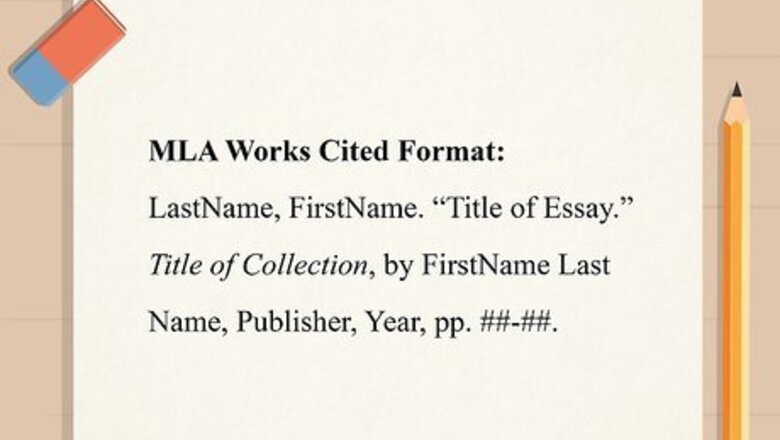
views
MLA
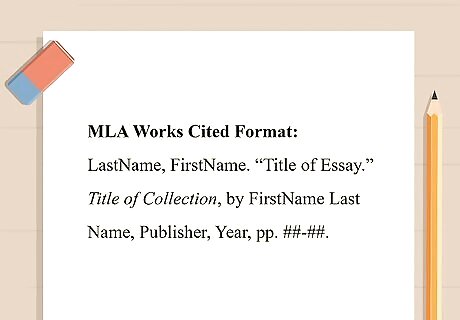
Start your Works Cited entry with the author of the essay. Type the last name of the author of the essay first, followed by a comma. Then, type the first name of the author of the essay, followed by a period. Example: Potter, Harry.
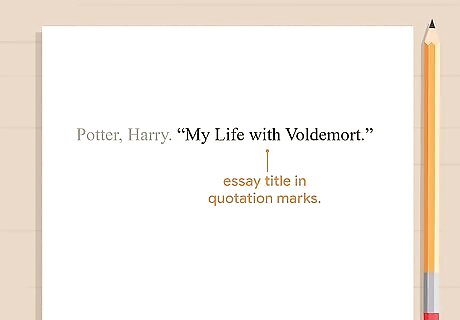
List the title of the essay in quotation marks. After the author's name, type the title of the essay in title case, capitalizing the first word and all nouns, pronouns, adjectives, adverbs, and verbs in the title. Place a period at the end of the title, inside the closing quotation marks. Example: Potter, Harry. "My Life with Voldemort."
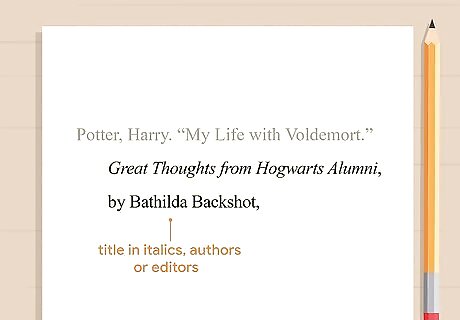
Provide the title and authors or editors of the larger work. Type the title of the larger work in italics, also using title case. Add a comma after the title followed by the word "by" and the author's name in first name-last name format. Place a comma after the author's name. Example: Potter, Harry. "My Life with Voldemort." Great Thoughts from Hogwarts Alumni, by Bathilda Backshot,
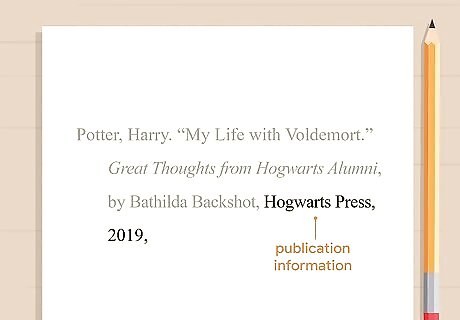
Add publication information for the larger work. Type the name of the publisher after the author's last name, followed by a comma. Then, add the year the work was published, also followed by a comma. Example: Potter, Harry. "My Life with Voldemort." Great Thoughts from Hogwarts Alumni, by Bathilda Backshot, Hogwarts Press, 2019,
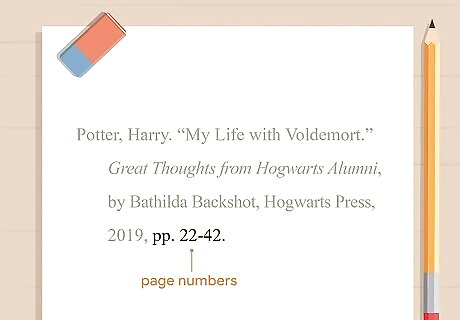
Include the page numbers where the essay is found. Because the essay is part of the larger work and your Works Cited entry cites only that essay, tell your readers where they can find it in the larger work. Type the abbreviation "pp." followed by the first page and the last page of the essay, separated by a hyphen. Place a period at the end of the final page number. Example: Potter, Harry. "My Life with Voldemort." Great Thoughts from Hogwarts Alumni, by Bathilda Backshot, Hogwarts Press, 2019, pp. 22-42. MLA Works Cited Entry Format: LastName, FirstName. "Title of Essay." Title of Collection, by FirstName Last Name, Publisher, Year, pp. ##-##.
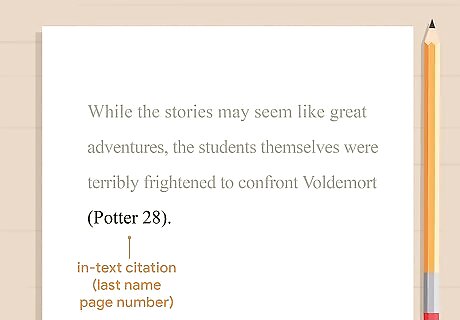
Use the author's last name and the page number for in-text citations. For example, you might write: While the stories may seem like great adventures, the students themselves were terribly frightened to confront Voldemort (Potter 28). If you include the author's name in the text of your paper, you only need the page number where the referenced material can be found in the parenthetical at the end of your sentence. If you have several authors with the same last name, include each author's first initial in your in-text citation to differentiate them. For several titles by the same author, include a shortened version of the title after the author's name (if the title isn't mentioned in your text).
APA
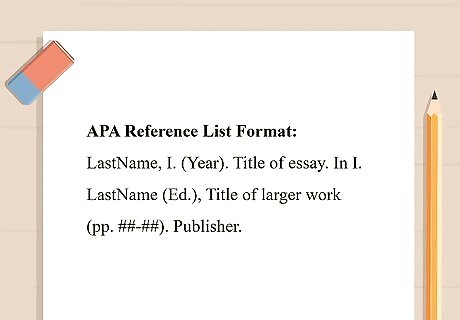
Place the author's name first in your Reference List entry. Type the author of the essay's last name first, followed by a comma. Then type the first initial of the author's first name. If the author's middle initial or name is included in the original source, add the middle initial after the first. Example: Granger, H.

Add the year the larger work was published. Type the year the larger work was published in parentheses after the name of the author. Place a period at the end, outside the closing parenthesis. Example: Granger, H. (2018).
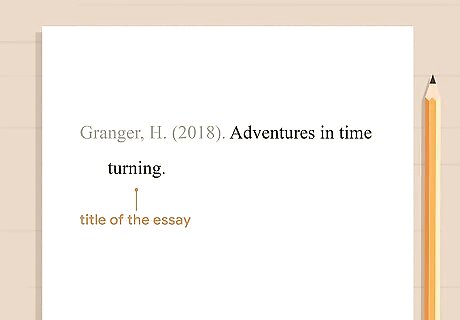
Include the title of the essay. Type the title of the essay in sentence case, capitalizing only the first word and any proper nouns in the title. If the essay has a subtitle, type a colon at the end of the title and then type the subtitle, also in sentence case. Place a period at the end. Example: Granger, H. (2018). Adventures in time turning.
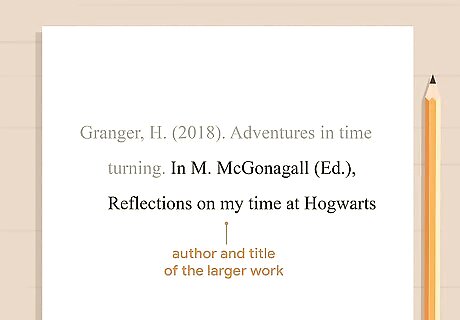
Provide the author and title of the larger work. Add the word "In," then type the first initial and last name of the author or editor of the larger work. If the person named is an editor, add the abbreviation "Ed." in parentheses after their name. Add a comma, then type the title of the larger work in sentence case. Don't include any punctuation at the end of the title. Example: Granger, H. (2018). Adventures in time turning. In M. McGonagall (Ed.), Reflections on my time at Hogwarts
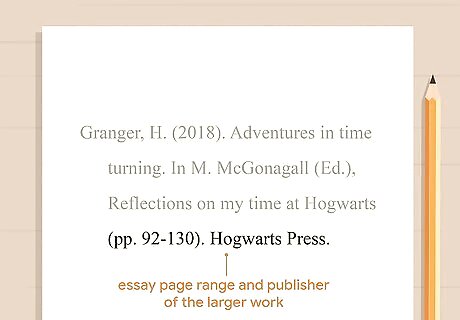
List the page range for the essay and the publisher of the larger work. Type a space after the title of the larger work, then type the page range where the essay appears in the larger work, enclosed in parentheses. Use the abbreviation "pp." and separate the first and last page numbers with a hyphen. Place a period at the end, outside the closing parenthesis. Close your Reference List entry with the name of the publisher, followed by a period. Example: Granger, H. (2018). Adventures in time turning. In M. McGonagall (Ed.), Reflections on my time at Hogwarts (pp. 92-130). Hogwarts Press. APA Reference List Entry Format: LastName, I. (Year). Title of essay. In I. LastName (Ed.), Title of larger work (pp. ##-##). Publisher.
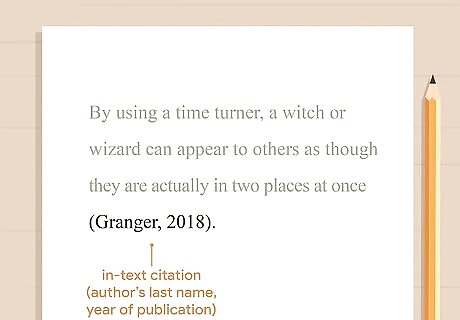
Use the author's last name and year of publication for in-text citations. APA style uses the author-date system for in-text citations. Type the last name of the author in parentheses, followed by a comma, then type the year of publication. A full parenthetical citation with the author and year goes at the end of any sentence that references the source, inside the closing punctuation for that sentence. For example, you might write: By using a time turner, a witch or wizard can appear to others as though they are actually in two places at once (Granger, 2018). If you use the author's name in the text of your paper, include the parenthetical with the year immediately after the author's name. For example, you might write: Although technically against the rules, Granger (2018) maintains that her use of a time turner was sanctioned by the head of her house. Add page numbers if you quote directly from the source. Simply add a comma after the year, then type the page number or page range where the quoted material can be found, using the abbreviation "p." for a single page or "pp." for a range of pages.
Chicago

Start your Bibliography entry with the name of the author of the essay. Type the last name of the author of the essay, followed by a comma. Then, type the author's first name, followed by a period. Example: Weasley, Ron.
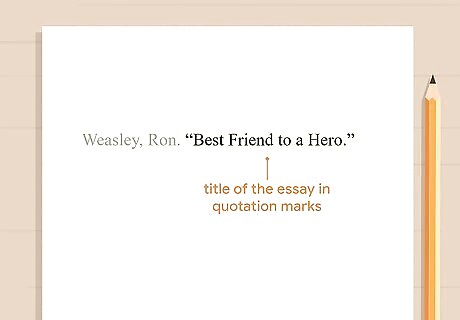
Include the title of the essay in quotation marks. Type the title of the essay in title case, capitalizing the first word and every noun, pronoun, adjective, adverb, and verb. Place a period at the end of the title, inside the closing quotation marks. Example: Weasley, Ron. "Best Friend to a Hero."
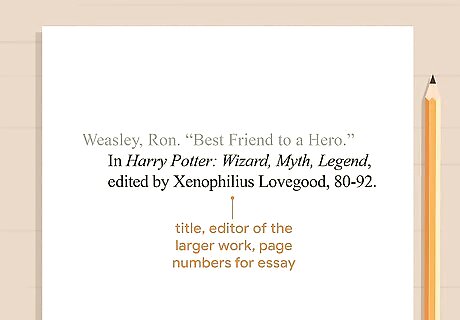
Add the title and editor of the larger work along with page numbers for the essay. Type the word "In" followed by the title of the larger work in italics. Place a comma after the title, then add the words "edited by" followed by the editor's name. Place a comma after the editor's name. Add the page range where the essay can be found, followed by a period. Example: Weasley, Ron. "Best Friend to a Hero." In Harry Potter: Wizard, Myth, Legend, edited by Xenophilius Lovegood, 80-92.

Provide publication information for the larger work. Type the location of the publisher, followed by a colon. Then, type the name of the publisher of the larger work, followed by a comma. Close your Bibliography entry with the year the larger work was published. Place a period at the end. Example: Weasley, Ron. "Best Friend to a Hero." In Harry Potter: Wizard, Myth, Legend, edited by Xenophilius Lovegood, 80-92. Ottery St. Catchpole: Quibbler Books, 2018. 'Chicago Bibliography Format: LastName, FirstName. "Title of Essay." In Title of Book or Essay Collection, edited by FirstName LastName, ##-##. Location: Publisher, Year.
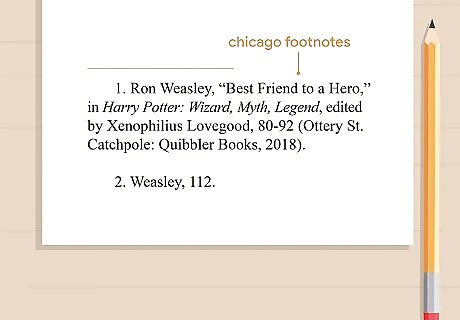
Adjust your formatting for footnotes. Your first footnote includes the same information as your Bibliography entry. However, it's formatted like a single sentence, using commas to separate the elements instead of periods. You also put the publication information in parentheses. The only period in the footnote appears at the end. Example: Ron Weasley, "Best Friend to a Hero," in Harry Potter: Wizard, Myth, Legend, edited by Xenophilius Lovegood, 80-92 (Ottery St. Catchpole: Quibbler Books, 2018). After the first footnote, use a shortened footnote format that includes only the author's last name, the title of the essay, and the page number or page range where the referenced material appears.Tip: If you use the Chicago author-date system for in-text citation, use the same in-text citation method as APA style.














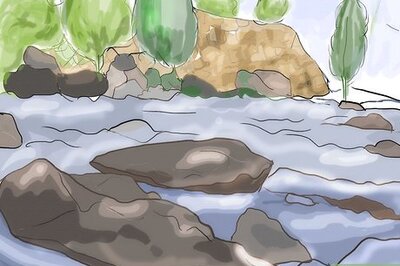
Comments
0 comment